
What is carbon capture?
Carbon dioxide (CO2) emissions generated by human activities have led to an accumulation of greenhouse gases in the atmosphere that is causing an increase in
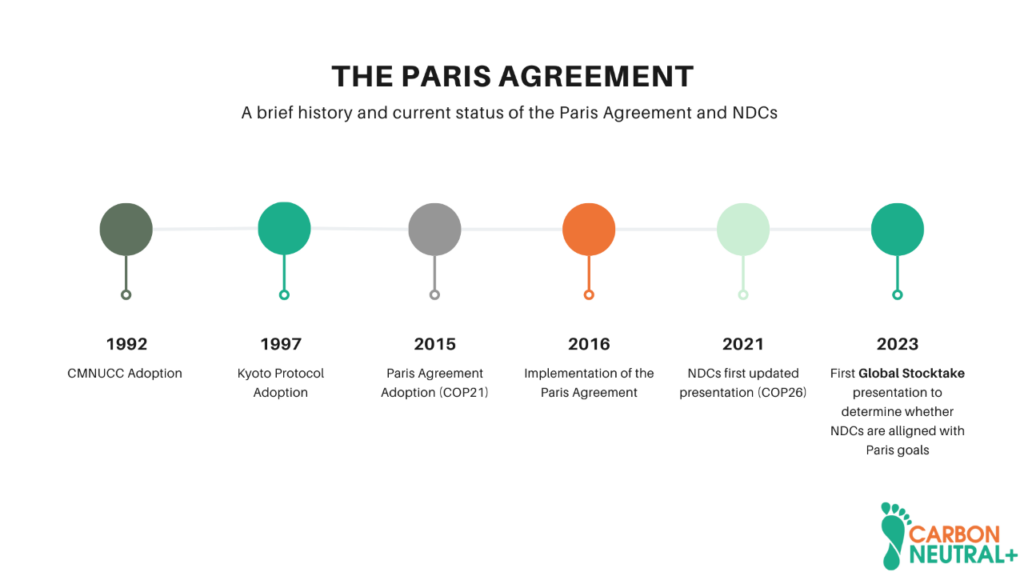
The Paris Agreement is an international agreement adopted on December 12, 2015 during the United Nations Climate Change Conference (COP21) in Paris, France. One of the main goals of the Paris Agreement is to limit the global temperature increase to below 2 degrees Celsius compared to pre-industrial levels.
This agreement is a major achievement in the fight against climate change, as it was one of the most ambitious agreements in the history of climate negotiations. The Paris Agreement entered into force on November 4, 2016, after at least 55 countries, representing 55% of global greenhouse gas (GHG) emissions, ratified it.
In this article we will tell you what are the main goals of the Paris Agreement and what are the other targets behind this negotiation. At the same time, we will detail the current status of compliance with the commitments of this agreement to date.
The Paris Agreement is a legal document that establishes a framework to reduce greenhouse gas emissions, which are the main cause of global warming and therefore, climate change. The ultimate goal is to establish commitments so that the average global temperature does not increase more than 2 degrees Celsius, and ideally no more than 1.5 degrees.
The Paris Agreement was signed in 2015 by 195 countries at COP21. The celebrations were affected by the withdrawal of the United States from the agreement during the Trump administration. But new President Biden reinstated the country into the Agreement in 2021.
The Paris Agreement is a key tool to be able to comply with the 2030 Agenda and the Sustainable Development Goals (SDGs). Beyond regulating emissions, the Agreement addresses issues like food security, equitable development and the importance of protecting all ecosystems.
To date, 197 countries have signed the Paris Agreement. Among them are the United States, China, the European Union, India, Russia and Japan, which are responsible for the majority of GHG emissions.
The Paris Agreement’s main goal is to limit the increase of the Earth’s global temperature. However, it also has other goals that seek to mitigate the imminent consequences of climate change.
Thus, another one of the goals of the Paris Agreement is to increase the adaptive capacity of countries that are most vulnerable to climate change. Also, it seeks to provide a framework for international cooperation in the fight against climate change.
Then, the main goals of the Paris Agreement signed in 2015 are:
The agreement seeks to reduce GHG emissions to achieve a balance between GHG emissions and removals in the second half of the century. This is how the Net-Zero target for the year 2050 was born. By that time, emissions need to be reduced by about 45 % by 2030 and to be net zero by 2050.
It is also intended that all GHG emissions that contribute to climate change will be quantified and those emissions that cannot be reduced will be offset through carbon offset projects. Thus, carbon credits represent a fundamental tool within the Net-Zero target.
If you want to learn more about these bonds, we invite you to visit our Marketplace, where you will be able to visualize different projects that can help your company to offset its GHG emissions.
The second one of the goals of the Paris agreement seeks to strengthen the capacity of countries to adapt to climate change and to cope with its adverse impacts. This means recognizing the imminent consequences of this phenomenon and beginning to make investments that increase the resilience of the most vulnerable communities.
Finally, the Paris Agreement recognizes the importance of financing to support climate action in developing countries and help these countries adapt to climate change and reduce their GHG emissions. The agreement sets a target of mobilizing $100 billion per year by 2020 and provides a framework for mobilizing and channeling climate finance.
The agreement seeks to mobilize funds to support climate action in developing countries and help these countries adapt to climate change and reduce their GHG emissions
Nationally Determined Contributions (NDCs) are climate action plans submitted by each country to reduce its greenhouse gas (GHG) emissions. In NDCs, each country establishes how much it will reduce its national GHG emissions and by when it will do so.
Countries must submit their plans every five years and increase their ambition over time. NDCs can include a variety of actions, such as promoting renewable energy, improving energy efficiency, reducing deforestation and improving sustainable agriculture.
The agreement also establishes a Green Climate Fund, which will provide funding to help developing countries adapt to climate change and reduce their emissions. In addition, the Paris Agreement recognizes the importance of technology transfer and cooperation in the fight against climate change.
Below is a summary of the current status of nationally submitted contributions (NDCs). These data were extracted from the Emissions Gap Report presented by UNEP in 2022:
However, it is important to mention that the nationally determined contributions fall short of the Paris Agreement targets (to limit global temperature to 1.5 degrees Celsius). The 2022 Emissions Gap Report mentions that:
“Full implementation of the non-conditional NDCs assumed by countries would result in an emissions gap with respect to the 1.5 °C scenario of 23 GtCO2e.”
In other words, in order to meet the goal of limiting the Earth’s temperature to 1.5 degrees by 2050, the NDCs need to be more ambitious (and achieve a reduction of 23 GtCO2e more than planned today).
The following image shows graphically the emissions gap mentioned above:
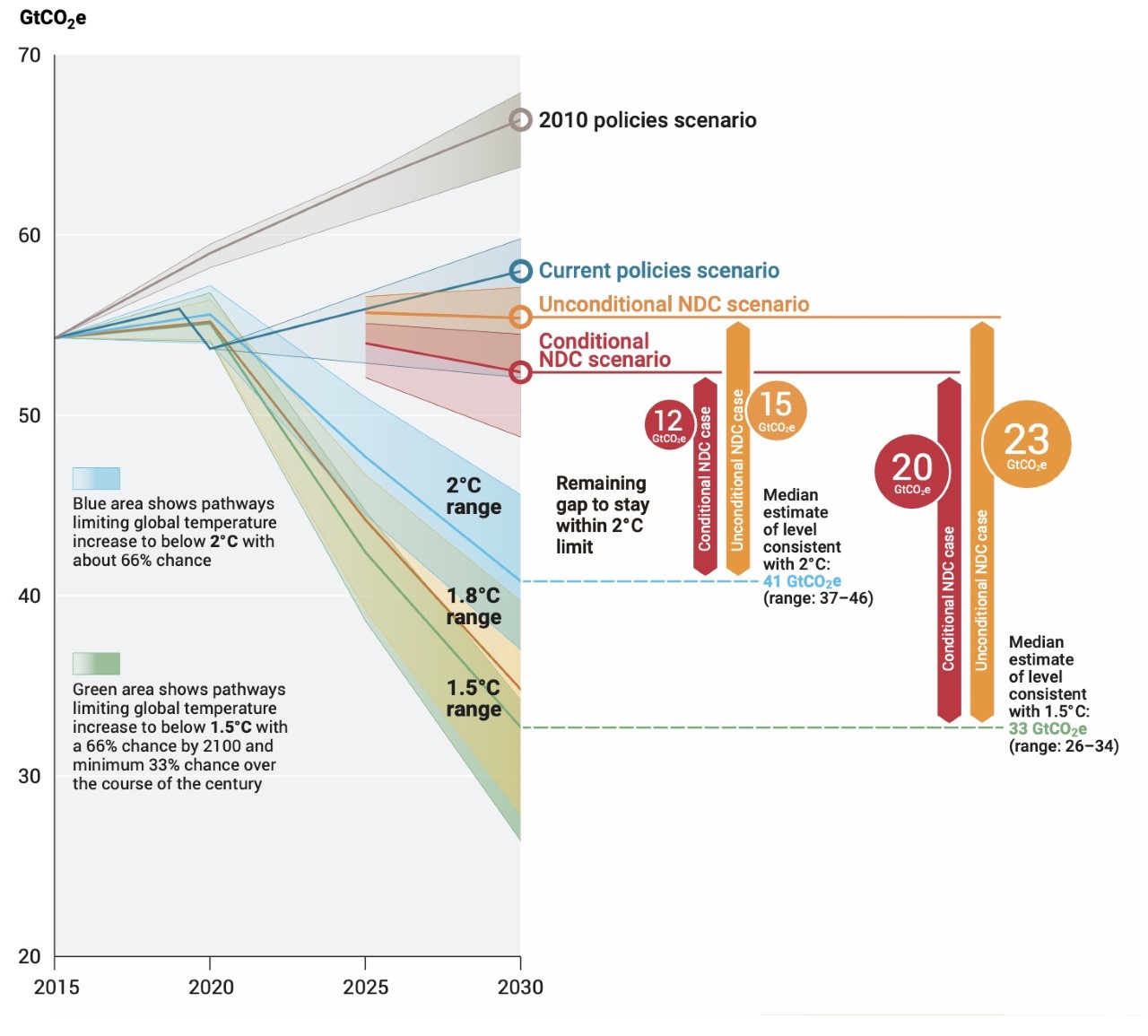
International negotiations on climate change began in 1992 with the adoption of the United Nations Framework Convention on Climate Change (UNFCCC). The goal of this convention was to stabilize greenhouse gas concentrations in the atmosphere at a level that will prevent dangerous human interference with the climate system.
Since then, the parties to the convention have met annually at United Nations climate change conferences, also known as COPs. During these conferences, delegates discuss and negotiate agreements and policies to address climate change.
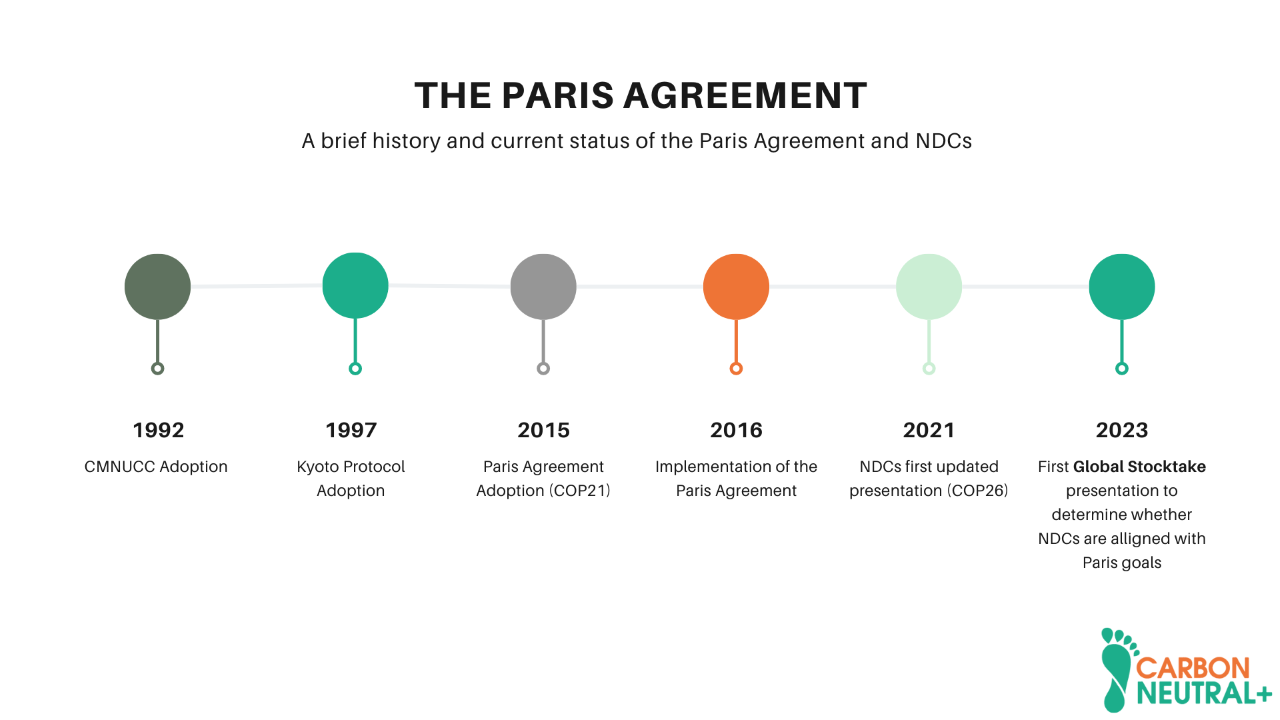
The Paris Agreement has been praised by many as an important step forward in the fight against climate change. It is seen as a landmark agreement that sets a clear goal and framework for international action in the fight against climate change.
However, it has also been criticized for not being ambitious enough and for not having strict enough compliance actions. This is because, as its name suggests, it is an agreement and not an obligation. That means that the countries agreed to meet GHG reduction targets but there are no penalties applied in case of non-compliance.
However, many other countries have reaffirmed their commitment to the agreement and have pledged to increase their NDC ambitions in the fight against climate change. In addition, civil society, businesses and cities around the world have taken an increasingly important role in the fight against climate change and have taken steps to reduce their emissions.
The goals of the Paris Agreement represent a significant step forward in global efforts to address the urgent threat of climate change. By committing to limit global warming to well below 2 degrees Celsius compared to pre-industrial levels and pursuing efforts to limit temperature rise to 1.5 degrees Celsius, the nations of the world have recognized the need for urgent action to reduce GHG emissions and transition to a low-carbon future.
While the Paris Agreement is not a perfect solution and there is still much work to be done, it has created a framework for international cooperation and provided a clear signal to governments, businesses and individuals around the world that action on climate change is essential.
The success of the goals of the Paris Agreement will depend on the commitment and action of all nations, as well as continued innovation and investment in clean energy and other climate solutions.
Ultimately, the Paris Agreement is a powerful reminder that the fate of our planet is in our hands and that together we can make a difference in ensuring a sustainable future for generations to come.
If you would like to learn more, please contact us.

Carbon dioxide (CO2) emissions generated by human activities have led to an accumulation of greenhouse gases in the atmosphere that is causing an increase in
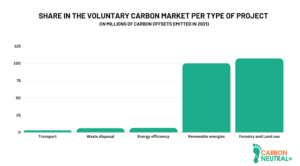
According to the Emissions Gap Report 2022, the growth rate of global greenhouse gas (GHG) emissions has declined over the last decade. Between 2010 and
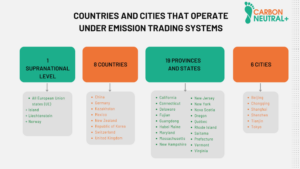
As international agreements related to corporate greenhouse gas emissions (GHG) come into force, the regulations associated with the generation of these emissions increase. This is
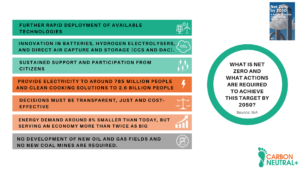
Climate change is one of the greatest concerns of our time. This phenomenon is generating consequences that are difficult to reverse, such as an increase

The Paris Agreement is an international agreement adopted on December 12, 2015 during the United Nations Climate Change Conference (COP21) in Paris, France. One of
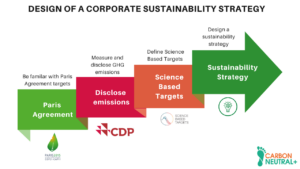
As the world faces the looming effects of climate change, more and more companies are recognizing the importance of adopting sustainable strategies that aim to
| Cookie | Duration | Description |
|---|---|---|
| cookielawinfo-checkbox-analytics | 11 months | This cookie is set by GDPR Cookie Consent plugin. The cookie is used to store the user consent for the cookies in the category "Analytics". |
| cookielawinfo-checkbox-functional | 11 months | The cookie is set by GDPR cookie consent to record the user consent for the cookies in the category "Functional". |
| cookielawinfo-checkbox-necessary | 11 months | This cookie is set by GDPR Cookie Consent plugin. The cookies is used to store the user consent for the cookies in the category "Necessary". |
| cookielawinfo-checkbox-others | 11 months | This cookie is set by GDPR Cookie Consent plugin. The cookie is used to store the user consent for the cookies in the category "Other. |
| cookielawinfo-checkbox-performance | 11 months | This cookie is set by GDPR Cookie Consent plugin. The cookie is used to store the user consent for the cookies in the category "Performance". |
| viewed_cookie_policy | 11 months | The cookie is set by the GDPR Cookie Consent plugin and is used to store whether or not user has consented to the use of cookies. It does not store any personal data. |